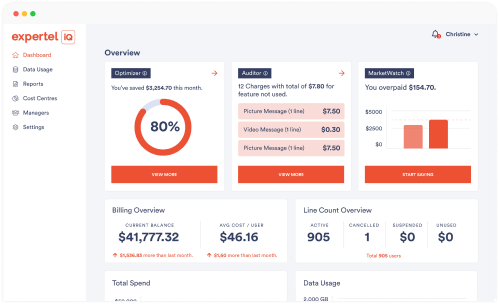How to Right-Size Your Business
In this Article:
It’s that time of the week again! Welcome back to Expertel’s blog, where we find useful tips to help your company save money on your telecom needs. In this entry, we’re going to take a different approach to savings, because today we’ll be giving you great ideas on how to optimize your budget to save more in the long term. Now, we understand that every business is different and so, they work differently, but we did our best to come up with ideas that can fit a company of every size. Before we begin, however, we want to “set the rules”. In this case, we’ll assume that you already have an ongoing contract, so we will not be starting from zero (that’s too easy!). Also, we will avoid the most obvious answers, such as cancelling contracts and starting new ones. Basically, we’ll be working with what you currently have. Those are the rules, and now that they’re set, we can get on with today’s topic. These are 6 ideas to help you find the right size for your company needs.
Floor space
Since the rest of the items in this list focus solely on mobile-related topics, we wanted to get the only item concerning wireless service out of the way from the very start. Our first idea on how to right-size your budget, is knowing the lay of the land. Office space varies from business to business, but if there’s one thing in common for a company of any size is the need for a strong and stable WIFI connection. Although you might have never really thought about it, having the right amount of router or repeater devices can help you downsize your budget. We’re not only talking about the fee you might incur to get the extra devices, but also about the energy costs of keeping them on and the eventual repair costs in case they break or get damaged. This might not represent a great deal of savings, but it should get you in the right frame of mind for what’s coming next.
When It Comes to Data: Use It,
Don’t Lose It
The first step into this week’s saving strategy has to do with understanding your company’s current data usage. Now, there are many ways to do this, but the cheapest method is basically tracking how much data is left in your pool by the end of the month. If your data pool is empty by the end of a month, then take note of how much data has to be added to fulfill your needs. You might find that some months require more data than others, but don’t worry about that just yet, for now, just focus on getting a good average number of data needed. The more monthly averages you take into account, the more precise will be the answer you get. As a good rule of thumb, we suggest using at least 4 monthly averages to get a firm benchmark, but we also recognize that time is money and math can be a little too time-consuming, which is why you can also take the easiest approach. If you’ve been following our blog for a while, you know we’re big supporters of Mobile Device Management. MDM allows you to skip all the tedious tracking and number crunching so you can get the most accurate data in just seconds. If you already have an MDM tool, you can track even further back to get a more accurate picture of your company data needs, so if your company has it, put it to work! Regardless of whether you chose to do it by hand or through an MDM, your final average will tell you the amount of data you should ask for at your next contract negotiation.
Stay Ahead of The Seasons
Let’s go back for a bit and talk about those differences in data consumptions between each month. You might have noticed that some months require more data than others. Those are your peaks and valleys, and they will help you to prepare your budget even better. You see, most companies usually have their distinct “up seasons”, when they have an extra amount of work to do and their “down seasons”, when they don’t get as many clients. This can be caused by a million different factors, depending on the market, products or services they offer. There isn’t much of a market for snow-plowing services during summer, for example. Keeping track of these “up seasons” and “down seasons” allows you to better understand your company’s data usage so your budget can be ready to adapt when either of them comes around.
Get Only What You Need
Okay, so now you have a good grasp of your company’s monthly average data needs, and you know when your peaks and valleys will be so you can better adapt your budget to them. Now, it’s time to find out if you can further streamline your budget by saving costs on unnecessary or unused features. In our latest case study, our client needed help managing and organizing 1,500 different cell phone lines (and their mismatched contracts). Even if your business doesn’t own that many devices, it’s not uncommon to find unused lines that are slowly draining your budget. To fix this, you can use your MDM tools to find out which lines are being used and which aren’t, you can check one by one to see if they’re active OR you can call Expertel and let Expertel iQ do all the work of analyzing your monthly bill and streamlining your contract in a matter of minutes, it’s your choice. At the end, what you’re trying to do is find out whether you can cancel a couple of lines for your next contract and recoup some money through a buy-back program (like ours!), while you’re at it.
Learning From the Present is Saving
for The Future
To get the perfect contract on your next round of negotiation, it’s not enough to know your current needs and the leeway you’ll need to be able to adapt for your peaks and valleys. To get the best deal, you need to plan for the future of your business too and by this, we mean planning future expansions or shrinkages. It doesn’t matter if you know your average monthly data usage, when your peaks and valleys are, and even having the right number of lines, if everything will change in a couple of months. Planning ahead can save you a great deal of money in the long run, and knowing when those changes will happen, and how big will they be, can make a huge difference when it comes to the transition itself. However, this doesn’t mean that switching office locations requires you to analyze everything about your current operations. Rather, if you’re planning to expand or reduce the current size of your business, then it makes sense to have a pretty good idea about how your current needs will change and whether or not you’ll need more or less tools and resources when that change happens. As such, we at Expertel believe that planning such a move 6 months in advance can give you enough time to evaluate your current needs as well as plan for the future with enough time to ensure a relatively seamless transition.
More Features, Less Profits
Our last idea has to do with extra features. Although having them “just in case” felt pretty smart when you were signing your current contract, there are many reasons to do a re-evaluation about how useful they are, or how frequently they’re being used. If your business requires you and your staff to travel a lot to work with international companies, it makes sense to have a low-cost roaming fee. However, if the people who travel represent a small portion of your business, then paying for the same roaming feature in every single line your company owns stops making sense. Small extra features can do wonders for your company, but it’s also important to recognize which of these features are really needed for your next contract, and which you can do without. In this case, the more devices you have, the more you’re spending on features you’re not using, so we recommend keeping a sharp eye on your budget to help you recognize which is which.These are just a few ideas we came up with in order to help you right-size your business, if you’re looking for even more ideas on how to right-size your business or want Expertel to help you get things done, feel free to get in touch with us by filling out the contact form you’ll find by following this link to our contact page.
We find the hidden savings in your wireless bill.
Expertel iQ is your cloud-based savings consultant. We optimize how much you can save per month by adding and removing account features based on what you’re actually using. Never pay for unused lines or redundant features again.







